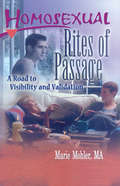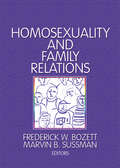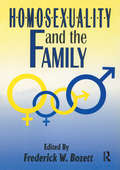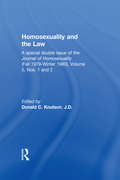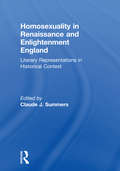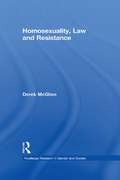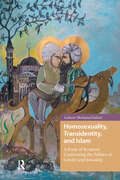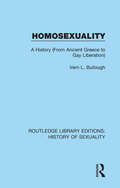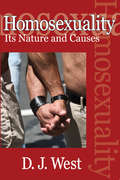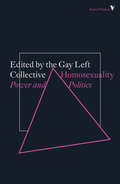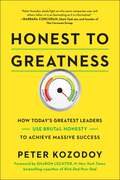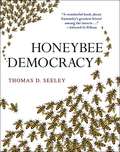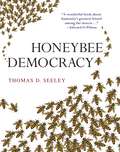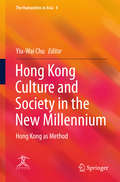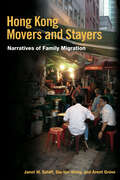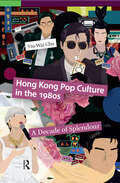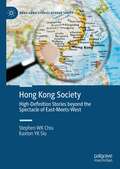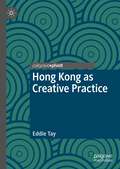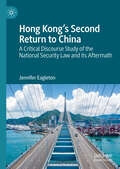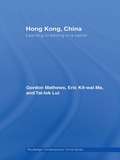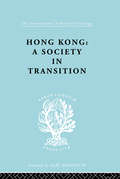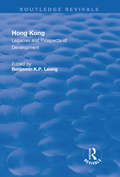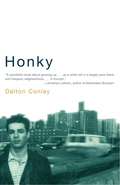- Table View
- List View
Homosexual Rites of Passage: A Road to Visibility and Validation
by Marie MohlerHomosexual Rites of Passage: A Road to Visibility and Validation will help you, as a gay or lesbian individual, work through identity issues, come out, and become visible in a healthy and safe manner. You will find this unique book to be an excellent resource for validation and support during your courageous acts of personal growth. Furthermore, you will discover a positive affirmation of homosexual identities as well as issues that impede or prevent your positive homosexual identity formation. Homosexual Rites of Passage facilitates your journey toward visibility and personal validation by naming fear and shame as obstacles of your growth and describing affirming homosexual rites of passage so that you will not feel alone in your journey through life. Throughout Homosexual Rites of Passage, you will explore the essential relationship between homosexual identity development and rites of passage, or life experiences or events that mark emotional, familial, and growth transitions in your life and that they are different for homosexuals than for heterosexuals. Compelling and informative, this important book discusses how homophobia and homosexuals’internalized shame often cause these rites of passage to be ignored or not considered valid rituals for gay men and lesbians. You will find helpful and insightful ideas in this informative book to help you affirm your homosexual identity, such as: discovering the definitions of the stages of homosexual identity formation and their significance in defining your view of self and others examining outlines and descriptions of obstacles that prevent positive homosexual identity development, such as fear, shame, and guilt learning to address the role and significance of rites of passage in creating personal identity and space analyzing the description of rites of passage that is specific to the homosexual community and that covers developmental milestones from birth to death, such as coming out or choosing a life partnerHomosexual Rites of Passage will assist your homosexual identity development through the celebration of homosexual rituals and rites of passage in a positive effective way. This valuable book addresses the issues that may impede your positive homosexual identity development and provides you with strategies to heal wounded and shamed identities, as well as providing you with a thorough description of homosexual rites of passage to help you understand and validate your homosexual identity.
Homosexuality and Family Relations
by Marvin B SussmanThe first book of its kind, Homosexuality and Family Relations focuses on the effects of homosexuality and being homosexual on individuals in families and on the family as a group. Edited by Frederick W. Bozett, RN, DNS, and Marvin B. Sussman, PhD, this informative and enlightening volume examines the multiple varieties of family forms in which gay men and lesbians live, addresses the ramifications of homosexuality on family relationships, and explores the countless aspects of parenthood as they are experienced by gay men and lesbians, including adoption and foster care by lesbians and gay men, and the choice of increasing numbers of lesbians to bear children through artificial fertilization. Any professional who is interested in the family--educators, clinicians, academicians, researchers, and students, as well as others interested in families and in human sexuality and men’s and women’s studies--family science, gay studies, nursing, medicine, law, psychology, sociology, social work--will find this book useful, insightful, and unique.
Homosexuality and the Family
by Frederick W. Bozett, RN, DNSDisproving the notion that homosexuals are antifamily, this enlightening book details the variety of family forms in which gays and lesbians live and explores the effects of homosexuality on individuals in families and on the family as a whole. Little in the professional literature addresses the combined topics of homosexuality and the family, so practitioners, academicians, researchers, and students in various disciplines--counseling, gay studies, sociology, human sexuality, psychology, social work, law, and medicine--will discover a wealth of unique and useful material here. Arranged in a life history sequence that moves from adolescence to adulthood, this informative volume documents the responses of parents of gay children, wives of gay men, children of lesbian mothers, and gay fathers about their family lives.
Homosexuality and the Law
by Donald C. Knutson, J.D.A fascinating exploration of how the law--as viewed and decided by the courts--often embodies fear and prejudice against homosexuality, and thereby, becomes the instrument for discrimination. This valuable book covers a wide range of subjects, illustrating the extent to which the lives of gay persons are touched by these laws and providing a highly critical examination of the response by the American judicial system to our claims for equal protection under the law. Leading law professors and practicing lawyers address the important legal issues and court decisions relevant to male and female homosexuality--criminal punishment for gay sex acts, employment discrimination, child custody, gay organizational rights, and more.
Homosexuality in Renaissance and Enlightenment England: Literary Representations in Historical Context
by Claude J SummersThis new book significantly contributes to an increased understanding of the gay and lesbian experience as it illuminates important works of literature and clarifies the status of same-sex desire in English literature from 1500--1760. Homosexual themes can be found throughout the literature of the English Renaissance and Enlightenment, but only rarely are they direct and unambiguous. The essays here are engaged in a vital and necessary process of re-historicizing and re-contextualizing literature. Utilizing a variety of critical methods and proceeding from several different theoretical and ideological presuppositions, these essays raise important questions about the methodology of gay studies, about the conception of same-sex desire, about the depiction of homoerotics, and about the relationship of sexuality and textuality, even as they shed new light on the homosexual import of a number of significant works of literature. Among the authors studied are Christopher Marlowe, William Shakespeare, John Donne, Lady Mary Wroth, Katherine Philips, Aphra Behn, John Cleland, and Thomas Gray. The collection attests both the current intellectual ferment in gay studies and the richness of English Renaissance and eighteenth-century literary representations of homosexuality.Homosexuality in Renaissance and Enlightenment England provides numerous insights into important works of literature and into significant theoretical issues implicit in the process of discerning and defining homosexuality in texts of earlier ages. All the contributors locate their texts in carefully delineated cultural and historical milieux. But they are not unduly constrained by either the tyranny of theory or the anxieties of anachronism. Rather than proceeding from hidebound or fashionably current ideologies, they sift the texts they study for the concrete evidence from which theories of sexuality might be constructed or modified. Hence, the collection will be valuable both for its practical criticism and for its theoretical contributions. It vividly illustrates the variety of gay studies in literature, especially as applied to works of earlier ages.
Homosexuality, Law and Resistance (Routledge Research in Gender and Society #Vol. 9)
by Derek McGheeThis book explores contemporary social theory and developments in the study of sexuality through the analysis of law and its practices. Each chapter explores the power of discourse in law in relation to homosexualities, while simultaneously examining how homosexuals resist and disrupt these legal discourses. It is a valuable addition to the literature of the fields of Sociology, Cultural Studies, Law, Politics, Gender Studies and Sexuality.
Homosexuality, Transidentity, and Islam: A Study of Scripture Confronting the Politics of Gender and Sexuality
by Ludovic-Mohamed ZahedWith a foreword from Jan Jaap de Ruiter. Translation and Afterword by Adi S. Bharat. -- In Homosexuality, Transidentity, and Islam: A Study of Scripture Confronting the Politics of Gender and Sexuality, Ludovic-Mohamed Zahed systematically analyses the entirety of Islamic scriptural sources that relate to the question of gender and sexuality in relation to their historical contexts. Through an approach that is certainly more politically engaged than that of most Islamic thinkers of our time, he clarifies key theological concepts that may seem esoteric to the uninitiated. In doing so, he makes a compelling case for the compatibility of sexual and gender diversity within Islam. Zahed also examines the historical and contemporary socio-political impacts of inclusive and exclusive (or, quite simply, homophobic, transphobic, and misogynistic) interpretations of scripture. This important study dynamically examines the connections between scripture, interpretation, and the politics of gender and sexuality.*This book builds on existing scholarship in a variety of disciplines on the topic of gender and sexuality in Islam.
Homosexuality: A History (From Ancient Greece to Gay Liberation) (Routledge Library Editions: History of Sexuality #2)
by Vern L. BulloughOriginally published in 1979. This is at once a look at the realities of homosexuality in history and an examination of the myths that have grown up around it. The record of practices and prejudices moves from biblical and classical through early and medieval Christian, Renaissance, and Victorian times, to our own era of dramatic changes. It looks at prominent figures who were homosexuals, the theories that have flourished and faded, the differing attitudes toward male and female homosexuality, persecution, and contemporary changes. This classic work is a fascinating historical perspective of all the factors that have shaped and changed our attitudes from ancient times to the present.
Homosexuality: Its Nature and Causes
by Donald J. WestThe subject of homosexuality, and especially male homosexuality, has received a great deal of publicity in England and America. The furor began with Kinsey's famous reports on sexual behavior, which brought out the fact that a far higher proportion of the population than was commonly supposed deviated from accepted standards of normality and morality. Taking courage from the apparent safety of large numbers, the sexually unorthodox and their sympathizers began to challenge the criteria of normality, and to question whether sexual habits that were widespread and so deeply entrenched could justifiably be written off as immoral. D.J. West's "Homosexuality" dissects the myths and paranoia surrounding this topic by examining the nature and roots of homosexuality.The politico-legal controversy has tended to overshadow the more fundamental psychological questions concerning the nature and causes of homosexuality. In this field, no striking discoveries have resulted from the increased public interest. Nevertheless, a body of factual data has accumulated, and a number of theories are available. The author's main purpose is to summarize as clearly as possible what is known, to draw what practical conclusions may be possible, and to point out where we are still groping and ignorant.This book deals mainly with male homosexuality because in men the condition causes more clear cut social problems and has been studied more intensely by psychiatrists. Unfortunately, though strongly held opinions abound, hard facts about homosexuality and its possible causes are difficult to obtain. Even now, serious medical and sociological investigations in this subject are scandalously few considering the importance of the questions in human terms. This resistance becomes acutely apparent when a social until a large section of the public is prepared to face the facts squarely and rationally and to support adequate research, our knowledge will remain rudimentary. This book clears away the debris of myth and misunderstanding in a vital area of social concern.
Homosexuality: Power and Politics
by Gay Left CollectiveA socialist journal edited by gay men in the 1970sAfter the leading organizations of radical sexual politics - the Gay Liberation Front and the Gay Marxist Group - imploded or dissolved, the Gay Left Collective formed a research group to make sense of the changing terrain of sexuality and politics writ large. Its goal was to formulate a rigorous Marxist analysis of sexual oppression, while linking together the struggle against homophobia with a wider array of struggles, all under the banner of socialism. This anthology combines the very best of their work, exploring masculinity and workplace organizing, counterculture and disco, the survivals of victorian morality and the onset of the HIV/AIDS crisis.
Honest Signals
by Alex Sandy PentlandHow can you know when someone is bluffing? Paying attention? Genuinely interested? The answer, writes Sandy Pentland in Honest Signals,is that subtle patterns in how we interact with other people reveal our attitudes toward them. These unconscious social signals are not just a back channel or a complement to our conscious language; they form a separate communication network. Biologically based "honest signaling," evolved from ancient primate signaling mechanisms, offers an unmatched window into our intentions, goals, and values. If we understand this ancient channel of communication, Pentland claims, we can accurately predict the outcomes of situations ranging from job interviews to first dates. Pentland, an MIT professor, has used a specially designed digital sensor worn like an ID badge--a "sociometer"--to monitor and analyze the back-and-forth patterns of signaling among groups of people. He and his researchers found that this second channel of communication, revolving not around words but around social relations, profoundly influences major decisions in our lives--even though we are largely unaware of it. Pentland presents the scientific background necessary for understanding this form of communication, applies it to examples of group behavior in real organizations, and shows how by "reading" our social networks we can become more successful at pitching an idea, getting a job, or closing a deal. Using this "network intelligence" theory of social signaling, Pentland describes how we can harness the intelligence of our social network to become better managers, workers, and communicators.
Honest to Greatness: How Today's Greatest Leaders Use Brutal Honesty to Achieve Massive Success
by Peter KozodoyIn today's hyper-transparent world, consumers have enormous power to decide which brands are worth their time and money—so how do you make sure they choose yours? Unfortunately, most leaders and organizations are stuck following archaic, detrimental business practices. Meanwhile, savvy consumers and employees across every generation are making their stance perfectly clear: They are not interested in supporting organizations that seem inauthentic, soulless, or untrustworthy. In this environment, only the honest will survive. In Honest to Greatness, serial Inc. 5000 entrepreneur Peter Kozodoy shows how today's greatest business leaders use honesty—not as a touchy-feely core value, but as a business strategy that produces game-changing, industry-dominating success. Through case studies and interviews with leaders at Bridgewater Associates, Sprint, Quicken Loans, Domino's, The Ritz-Carlton, and more, Kozodoy presents fresh business concepts that anyone in the workplace can implement in order to: Reach, engage, and retain your best customers Attract and inspire the best talent in any industry Create an unbeatable culture of innovation that dominates your competitors Earn your team's respect and loyalty Unlock deep personal fulfillment by setting the "right" goals Filled with powerful lessons for current and future leaders, this timely book demonstrates how to use honesty at both the organizational and individual level to achieve true greatness in business and in life.
Honeybee Democracy
by Thomas D. SeeleyHoneybees make decisions collectively--and democratically. Every year, faced with the life-or-death problem of choosing and traveling to a new home, honeybees stake everything on a process that includes collective fact-finding, vigorous debate, and consensus building. In fact, as world-renowned animal behaviorist Thomas Seeley reveals, these incredible insects have much to teach us when it comes to collective wisdom and effective decision making. A remarkable and richly illustrated account of scientific discovery, Honeybee Democracy brings together, for the first time, decades of Seeley's pioneering research to tell the amazing story of house hunting and democratic debate among the honeybees. In the late spring and early summer, as a bee colony becomes overcrowded, a third of the hive stays behind and rears a new queen, while a swarm of thousands departs with the old queen to produce a daughter colony. Seeley describes how these bees evaluate potential nest sites, advertise their discoveries to one another, engage in open deliberation, choose a final site, and navigate together--as a swirling cloud of bees--to their new home. Seeley investigates how evolution has honed the decision-making methods of honeybees over millions of years, and he considers similarities between the ways that bee swarms and primate brains process information. He concludes that what works well for bees can also work well for people: any decision-making group should consist of individuals with shared interests and mutual respect, a leader's influence should be minimized, debate should be relied upon, diverse solutions should be sought, and the majority should be counted on for a dependable resolution. An impressive exploration of animal behavior, Honeybee Democracy shows that decision-making groups, whether honeybee or human, can be smarter than even the smartest individuals in them.
Honeybee Democracy
by Thomas D. SeeleyHow honeybees make collective decisions—and what we can learn from this amazing democratic processHoneybees make decisions collectively—and democratically. Every year, faced with the life-or-death problem of choosing and traveling to a new home, honeybees stake everything on a process that includes collective fact-finding, vigorous debate, and consensus building. In fact, as world-renowned animal behaviorist Thomas Seeley reveals, these incredible insects have much to teach us when it comes to collective wisdom and effective decision making. A remarkable and richly illustrated account of scientific discovery, Honeybee Democracy brings together, for the first time, decades of Seeley's pioneering research to tell the amazing story of house hunting and democratic debate among the honeybees.In the late spring and early summer, as a bee colony becomes overcrowded, a third of the hive stays behind and rears a new queen, while a swarm of thousands departs with the old queen to produce a daughter colony. Seeley describes how these bees evaluate potential nest sites, advertise their discoveries to one another, engage in open deliberation, choose a final site, and navigate together—as a swirling cloud of bees—to their new home. Seeley investigates how evolution has honed the decision-making methods of honeybees over millions of years, and he considers similarities between the ways that bee swarms and primate brains process information. He concludes that what works well for bees can also work well for people: any decision-making group should consist of individuals with shared interests and mutual respect, a leader's influence should be minimized, debate should be relied upon, diverse solutions should be sought, and the majority should be counted on for a dependable resolution.An impressive exploration of animal behavior, Honeybee Democracy shows that decision-making groups, whether honeybee or human, can be smarter than even the smartest individuals in them.
Hong Kong Culture and Society in the New Millennium
by Yiu-Wai ChuThis book discusses the notion of "Hong Kong as Method" as it relates to the rise of China in the context of Asianization. It explores new Hong Kong imaginaries with regard to the complex relationship between the local, the national and the global. The major theoretical thrust of the book is to address the reconfiguration of Hong Kong's culture and society in an age of global modernity from the standpoints of different disciplines, exploring the possibilities of approaching Hong Kong as a method. Through critical inquiries into different fields related to Hong Kong's culture and society, including gender, resistance and minorities, various perspectives on the country's culture and society can be re-assessed. New directions and guidelines related to Hong Kong are also presented, offering a unique resource for researchers and students in the fields of cultural studies, media studies, postcolonial studies, globalization and Asian studies.
Hong Kong Internment, 1942-1945
by Geoffrey Charles Emerson'Hong Kong Internment, 1942-1945: Life in the Japanese Civilian Camp at Stanley' tells the story of the more than three thousand non-Chinese civilians: British, American, Dutch and others, who were trapped in the British colony and interned behind barbed wire in Stanley Internment Camp from 1942 to 1945. From 1970 to 1972, while researching for his MA thesis, the author interviewed twenty-three former Stanley internees. During these meetings, the internees talked about their lives in the Stanley Camp during the Japanese occupation. Long regarded as an invaluable reference and frequently consulted as a primary source on Stanley since its completion in 1973, the study is now republished with a new introduction and fresh discussions that recognize later work and information released since the original thesis was written. Additional illustrations, including a new map and photographs, as well as an up-to-date bibliography, have also been included in the book.
Hong Kong Movers and Stayers: Narratives of Family Migration (Studies of World Migrations)
by Siu-lun Wong Janet W. Salaff Arent GreveHalf a million Hong Kong residents fled their homeland during the thirteen years before Hong Kong's reversion to China in 1997. Nearly half of those returned within the next several years. Filled with detailed, first-hand stories of nine Hong Kong families over nearly two decades, Hong Kong Movers and Stayers is a multifaceted yet intimate look at the forces behind Hong Kong families' successful, and failed, efforts at migration and settlement. Defining migration as a process, not a single act of leaving, Hong Kong Movers and Stayers provides an antidote to ethnocentric and simplistic theories by uncovering migration stories as they relate to social structures and social capital. The authors meld survey analysis, personal biography, and sociology and compare multiple families in order to give voice to the interplay of gender, age, and diverse family roles as motivating factors in migration.
Hong Kong Pop Culture in the 1980s: A Decade of Splendour (Asian Visual Cultures)
by Yiu-Wai ChuThis book deals with the 1980s – the “golden decade” of Hong Kong pop culture – in which a cosmopolitan lifestyle of pop and chic emerged in the city. Bookended by two major historical incidents, the 1980s will probably enter the annals of Hong Kong history as the decade that defined its future after reversion to Mainland China. Having witnessed and experienced the rise of Hong Kong pop culture to unprecedented heights in this decade, the author enhances its context through a story about his own personal belongings. Examining popular genres including television, film, music, fashion, disco and city magazine, this book teases out the distinctive aspects of Hong Kong pop culture that defined (his) Hong Kong. As Hong Kong has been undergoing drastic changes in recent years, it is necessary to point toward new imaginaries by re-examining its development. Toward this end, this book will shed light on an important research area of Hong Kong Studies as an academic discipline.
Hong Kong Society: High-Definition Stories beyond the Spectacle of East-Meets-West (Hong Kong Studies Reader Series)
by Stephen WK Chiu Kaxton YK SiuThis book borrows the concept of “high-definition” from digital broadcasting to highlight our unique approach to Hong Kong society, which gives a sharper image than analyses. It intends to highlight contrasts with many common and taken-for-granted stories, myths and representations of Hong Kong— which often presented with a low level of detail, lacking proper connections between grounded personal experiences and the macro social context. With chapters covering various salient dimensions of Hong Kong’s society, including migration, economy, inequality, identity and social movements, our “high-definition” approach presents images with high enough “resolution” to match multiple layers of experiences from walks of life of Hong Kong people, contributing to an understanding of how global transformation impacts local people’s experiences, as well as Hong Kong’s significance in the regional and global system.
Hong Kong as Creative Practice (Palgrave Studies in Creativity and Culture)
by Eddie TayIn this book, Hong Kong is seen as a labyrinth, a postmodern site of capitalist desires, and a panoptic space both homely and unhomely. The author maps out various specific locations of the city through the intertwined disciplines of street photography, autoethnography and psychogeography. By meandering through the urban landscape and taking street photographs, this form of practice is open to the various metaphors, atmospheres and visual discourses offered up by the street scenes. The result is a practice-led research project informed by both documentary and creative writing that seeks to articulate thinking via the process of art-making. As a research project on the affective mapping of places in the city, the book examines what Hong Kong is, as thought and felt by the person on the street. It explores the everyday experiences afforded by the city through the figure of the flâneur wandering in shopping districts and street markets. Through his own street photographs and drawing from the writings of Byung-Chul Han, Walter Benjamin and Michel de Certeau, the author explores feelings, affects, and states of mind as he explores the city and its social life.
Hong Kong's Second Return to China: A Critical Discourse Study of the National Security Law and its Aftermath
by Jennifer EagletonThis book is a cross-disciplinary study, incorporating political science, law, and sociolinguistics in its examination of Hong Kong&’s National Security Law which has impacted many aspects of life in the city. Through a critical discourse analysis lens, it details the lead-up to the Law&’s introduction in 2020, a textual analysis of the Law itself, the &“selling&” the Law to the public, the accompanying electoral changes, the effect on civil society, and the discourse of dissidents in exile. It ends with speculation on what the future will bring to the so-called &“One Country, Two Systems&” as it goes forward. The book caters for the general reader, the university student, and seasoned academic who want to be informed about the changes in Hong Kong as it transitions to be more &“fully China&”. The book ultimately argues that the &“One Country, Two Systems&” experimental framework had always been problematic from both a rhetorical and ideological perspective.
Hong Kong, China: Learning to belong to a nation (Routledge Contemporary China Series #10)
by Gordon Mathews Tai-Lok Lui Eric MaThe idea of ‘national identity’ is an ambiguous one for Hong Kong. Returned to the national embrace of China on 1 July 1997 after 150 years as a British colony, the concept of national identity and what it means to "belong to a nation" is a matter of great tension and contestation in Hong Kong. Written by three academic specialists on Hong Kong cultural identity, social history, and mass media, this book explores the processes through which the people of Hong Kong are "learning to belong to a nation" by examining their relationship with the Chinese nation and state in the recent past, present, and future. It considers the complex meanings of and debates over national identity in Hong Kong over the past fifty years and especially during the last decade following Hong Kong’s return to China. It also places these arguments within a larger, global perspective, to ask what Hong Kong can teach us about national identity and its potential transformations. Multidisciplinary in its approach, Hong Kong and China explores national identity in terms of theory, mass media, survey date, ethnography and history, and will appeal to students and scholars of Chinese history, cultural studies, and nationalism.
Hong Kong: A Society in Transition (International Library of Sociology)
by I.C. JarvieThis is Volume IV in a series of six on the Sociology of East Asia. Originally published in 1969, the aim was to fill the lack of sociological studies of Hong Kong at the time.
Hong Kong: Legacies and Prospects of Development
by Benjamin K.P. LeungThis title was first published in 2003. Hong Kong is a society of contrasts and paradoxes. The city has a contrasting and yet fluid intermingling of social and cultural images - east and west, local and colonial, modern and traditional, extravagant and frugal. In this volume, the editor has selected essays dealing with a variety of aspects of Hong Kong including change and development, culture and identity, trends in political development, economy and society, social issues and social policy.
Honky
by Dalton ConleyThe author recalls how his childhood had all of the classic elements of growing up in America. His entertaining memoir as child, teenager and adult reveals how race and class impact all of us.
